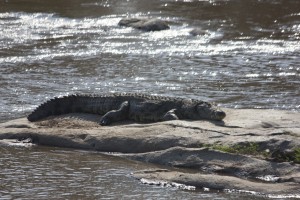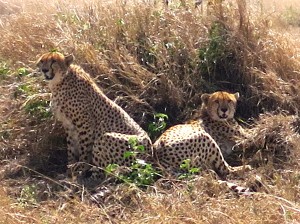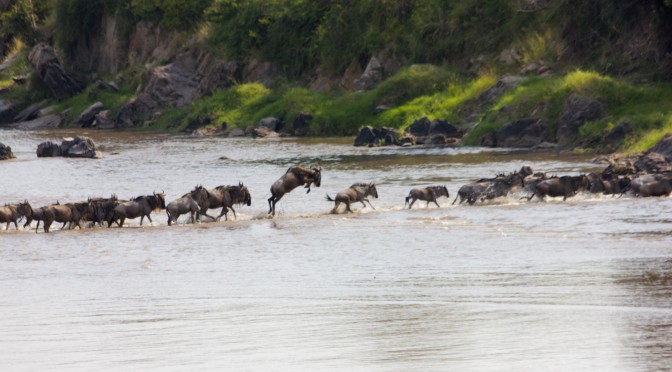The dust being kicked up by thousands of wildebeests as they charge the Mara River can be seen from a mile away. These animals know they must be quick as they cross the river; it can make the difference between life and death. The crocodiles are waiting but they’re not  the only danger, some of these animals will break a leg on the river rocks rendering them immobile and some will get trampled by the herd.
the only danger, some of these animals will break a leg on the river rocks rendering them immobile and some will get trampled by the herd.
The wildebeests, also known as gnus, are on their annual search for food on a route that takes them from the southern Serengeti in Tanzania into Kenya and eventually back across the river to the  south. Seeing about a million animals lining the fields on the river’s bank is an astonishing sight. When the wildebeests are on the move they walk in a line that extends past the horizon leaving a visible trail in the dry grass.
south. Seeing about a million animals lining the fields on the river’s bank is an astonishing sight. When the wildebeests are on the move they walk in a line that extends past the horizon leaving a visible trail in the dry grass.
As the wildebeests gather in groups at the river’s edge they sound like a swarm of bees. The group waits for one brave leader to start the crossing which can take hours of milling around before they are ready.  We have to hide our vehicle behind a tree. If the herd sees us they won’t start the crossing. When the dust begins to kick up we are able to move closer to view this incredible sight. Once the wildebeests start the charge they are only focused on crossing the river.
We have to hide our vehicle behind a tree. If the herd sees us they won’t start the crossing. When the dust begins to kick up we are able to move closer to view this incredible sight. Once the wildebeests start the charge they are only focused on crossing the river.
Seeing a crossing is all about timing and thankfully ours was great. We saw three river crossings in 3 days and I was pleased that not  one of them involved crocodiles! Please click here to see the video I posted on YouTube.
one of them involved crocodiles! Please click here to see the video I posted on YouTube.
The Serengeti is a special place. In my next post I will share with you lions mating and a cheetah having rabbit for lunch. The sad thing is we did not see one rhinoceros. Poaching, for their horn, has  made some species of the rhino extinct. Even today they are still being hunted because people in some cultures actually believe the ground up horn can act as an aphrodisiac and others use the horn to make a handle for knives.
made some species of the rhino extinct. Even today they are still being hunted because people in some cultures actually believe the ground up horn can act as an aphrodisiac and others use the horn to make a handle for knives.
If anyone has any specific animal request let me know I will see if I can deliver.

